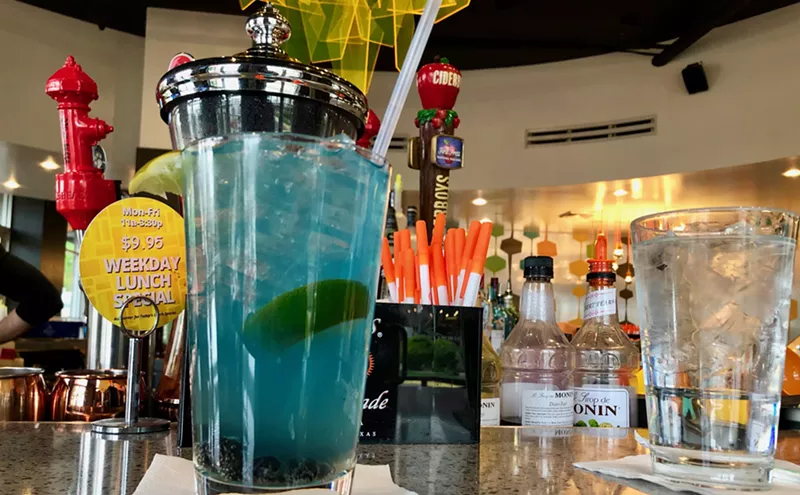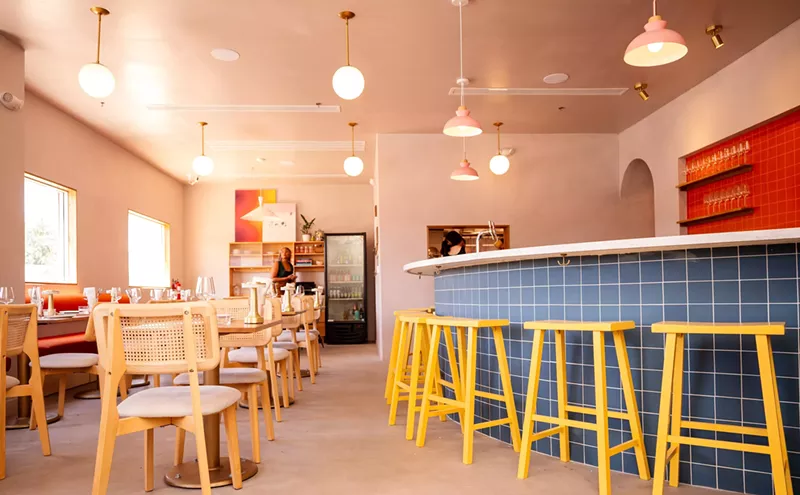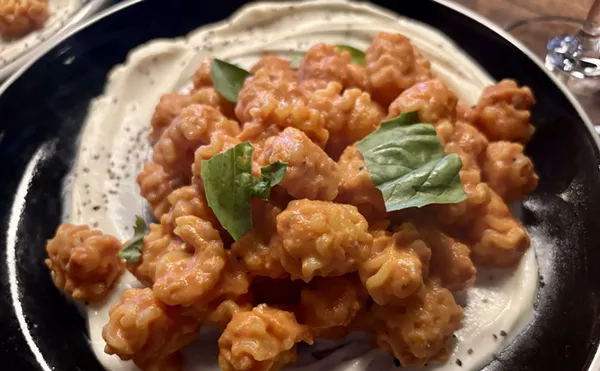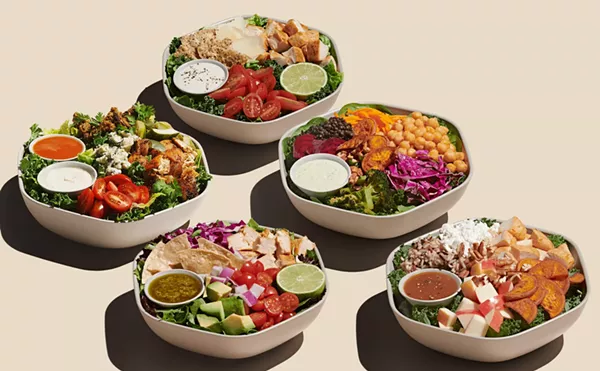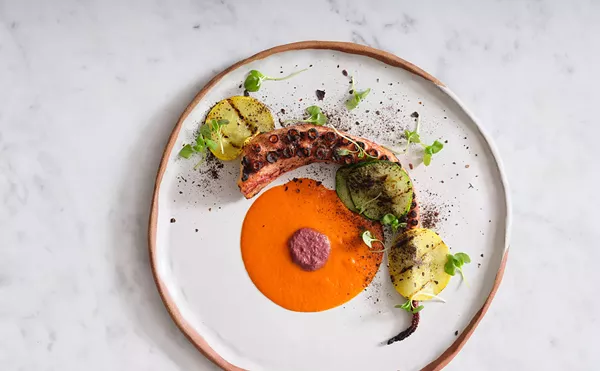During the Cold War, one wag tried to sum up the difference between the Soviet and American systems.
"Under communism," he explained, "man exploits man. But in a capitalist society, it's exactly the opposite."
Yes, there's a downside to letting free-market forces operate without check. It seems everything is for sale these days, from health care and education to JFK's golf clubs and what's left of the Sonoran Desert.
On the other hand, letting a bunch of we-know-what's-good-for-you commissars plan our lives doesn't sound terribly appealing, either. Imagine, if you dare, a Valley run by Comrade Joe Arpaio.
When it comes to restaurants, the free market's Invisible Hand is clearly preferable to the Iron Fist. Look how swiftly and efficiently it's working in the northeast Valley.
Restaurant operators are attracted to that burgeoning, affluent section of town for the same reason bank robbers are attracted to banks: That's where the money is. It's a textbook case of supply and demand. The residents are eager to eat out, and the restaurant owners are eager to feed them.
But what kind of restaurant is most likely to succeed? After studying the market, several entrepreneurs seem to have simultaneously reached the same conclusion. Over the past few months, they've opened a number of new Middle Eastern restaurants. The decision makes business sense. Both Wine & Kebab and Saba's Mediterranean Cuisine have moved into an area without cheap ethnic joints in general, and without Middle Eastern restaurants in particular.
The proprietors have done their homework--demographically and competitively, the situation looks promising. Now the question is, can their kitchens deliver on that promise?
Wine & Kebab operates out of the same storefront that used to house Zweig's, a deli of no distinction. Locals will appreciate the improvement.
The restaurant's Iranian owner comes armed with experience--he also runs Shish Kebab House, a Middle Eastern skewer parlor on the west side. He's put that experience to good use, wisely fashioning his new place to appeal to neighborhood tastes.
First, the look. Unlike the west-side operation, Wine & Kebab is surprisingly charming for a shopping-center storefront. The small room is very pretty, from the swirling print tablecloths under glass to the flowery wallpaper that reminds me of the intricate background on Persian miniatures. The pitchers that hold colorful sprays of purple silk flowers are another nice touch. On the west side, I recall the restaurant incongruously piping in country music. Here, on the other hand, the music and the food share the same origins.
And, I'm happy to relate, the Iranian-accented food is generally topnotch, authentic and affordable.
The menu is small. Appetizers are limited to hummus, a chickpea dip; a refreshing yogurt and cucumber blend that Iranians also use to juice up their main dishes; and first-rate dolmeh, exceptionally moist grape leaves stuffed with rice and onions. There's also hummus blended with eggplant. It's a combo I never encountered in my years in the Middle East, but the thick, fragrant mix, which you scoop on pita bread, doesn't take long to get used to.
The main dishes are those you'd find at chelo kebabi, unpretentious, inexpensive restaurants found on every street corner in Iran, which specialize in dishes made from skewered meat and rice.
For carnivores, entrees are quite a good value--you can get lots of animal protein for under ten bucks. Two chelo kebabi staples are koobideh and barg. The former is skewered ground beef, packed with onions and seasonings. (Iranian food is highly spiced, but never spicy hot.) Barg is thin, tender, marinated strips of tenderloin, right out of the broiler, as good as just about any steak in town, and at half the price. A best bet is to order the barg-koobideh combo. Throughout the Middle East, it's called Sultani--fit for a Sultan.
All dinner platters come with the traditional broiled tomato and an Iranian-size mound of perfumed basmati rice. What's an Iranian-size mound of rice? It means there's enough rice for two or three average Americans. (When I visited the west-side store about two years ago, the proprietor served cheaper American rice, not basmati. I guess he figures it's too risky cutting corners in this tonier part of town.)
On each table, you'll find a purple spice called sumac. Sprinkle some on--you may enjoy the tart, offbeat flavor. The owner will also obligingly deliver raw onion, an essential component of an Iranian kebab dinner that not all Americans instantly appreciate.
Shish kebab differs from barg in shape, not substance. Here the beef tenderloin comes in chunks, not thin strips, accompanied by green peppers and onions. A zestily marinated whole, small, Cornish hen is also deftly done, strung along a skewer, bones and all. (You can also get boneless poultry, but it's not quite as tasty.) There's also fish kebab, made with filleted chunks of broiled whitefish, deeply marinated with lemon and olive oil. One menu shortcoming: no lamb.
If you enjoy adventure, you can wash everything down with doogh, a yogurt drink seasoned with salt and mint. It's an acquired taste I managed not to acquire in the two years I spent in Iran. (My wife, on the other hand, chugs it like a native.) For liquid refreshment, I prefer the authentic Iranian mint tea.
Wine & Kebab seems to be in the right place at the right time, delivering tempting, low-cost ethnic meals in a high-rent district. It should flourish.
Saba's Mediterranean Cuisine, 4747 East Bell, Phoenix, 493-4831. Hours: Lunch, Monday, 11 a.m. to 4 p.m.; Lunch and Dinner, Tuesday through Saturday, 11 a.m. to 9 p.m.; Sunday, noon to 7 p.m.
Despite being buried in a sprawling shopping center at the busy southwest corner of Tatum and Bell, Saba's seems to have been discovered by the neighborhood.
It's not surprising that locals have taken to it--it's a friendly family operation with a welcoming feel. The narrow room is decked out with posters of Jerusalem, embroidered Arabic verses surrounded by flags of the region and a small retail shelf stocked with Middle Eastern goods. You can even pick up a copy of the Jerusalem Post.
But it's not the decor or reading matter that's attracting customers. It's the food--especially the appetizers. Saba's has some of the best in town.
You can get a good sampling of them on the appetizer combo platter. Baba ghanouj is notable for its smoky, roasted-eggplant aroma, a scent that excites me as much as Chanel No. 5. Hummus and falafel are also well-crafted, the latter particularly fresh, moist and crunchy. Rice-stuffed dolmeh sports a tangy lemon bite. You also get to munch on three varieties of olives and feta cheese.
Fattouch, a Lebanese bread salad, also shifts your taste buds into high gear. Bits of toasted pita bread are tossed with lettuce, tomatoes, cucumbers, parsley and scallions, in an invigorating oil-and-lemon dressing.
But the kitchen really reaches the heights with the tabbouleh and kibbe mishewy starters. For many years, we had Lebanese neighbors, victims of the civil war who fled here to escape the fighting. The wife made tabbouleh--a blend of parsley and cracked wheat, seasoned with onion, mint, oil and lemon--that was an absolute knockout. Saba's lip-smacking version is in the same league. It arrives in a huge bowl, plenty for four to share, with fresh pita bread. I could have made a meal of it.
But then I would have missed the kibbe mishewy, an extraordinarily flavorful dish that transported me back to the Middle East faster than a magic carpet. It's fashioned from ground meat, cracked wheat, onion, pine nuts and a sprinkling of cinnamon. The ingredients are rolled into a ball, then fried. You get two to an order, and you won't want to share.
Maybe the wonderful appetizers raised my expectations beyond a reasonable level. But I didn't think the main dishes reached quite the same heights. They're good, but not good enough to make me quiver with excitement.
The Sultani kebab combo--a skewer each of marinated steak and ground beef--suffered from overcooking. Although skillfully seasoned, the steak wasn't as tender as it ought to have been, and the ground beef wasn't as moist. Lamb kebab was too gristly, and also spent too much time in the broiler.
Chicken dishes fared better. Joojeh kebab features skinless, boneless, marinated poultry, expertly grilled. Shawarma chicken uses a lemon-and-garlic marinade to zip up strips of chicken breast. Baked prawns make another good alternative, although this shrimp dish smacks more of Greece than the Middle East. (Muslims, like Jews, are not permitted to eat shellfish.) The five shrimp, coated with a lovely tomato-wine sauce festooned with feta cheese, may not pass every religious test. But they do pass the taste test.
Two cavils. Neither the soup nor the salad that accompanies dinner is worth your dining attention. And, for some reason, the kitchen is stingy with rice, which didn't do much for either my sense of authenticity or my growling belly.
Stick around for dessert. Both the sweet, syrupy baklava and the burma, a confection made from shredded phyllo dough and walnuts, end the meal on a pleasant note. So does the minty Middle Eastern tea.
Saba's appetizers indicate that someone in the kitchen possesses real culinary skill. Let's hope the main dishes will soon receive that same level of attention. If they do, Saba's may become more than a welcome new neighborhood ethnic spot--it could be a Valley dining destination, as well.
Wine & Kebab:
Hummus and eggplant
$3.95
Koobideh kebab
6.95
Cornish hen kebab
8.45
Barg kebab
9.45
Saba's Mediterranean
Kibbe mishewy
$3.25
Tabbouleh
3.75
Joojeh kebab
7.95
Baked prawns
10.75



